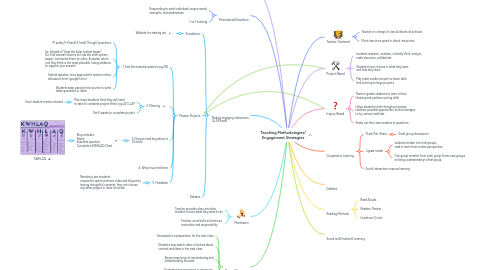
1. Student-Centered/ Constructivist
1.1. Small gorups, learning centers, flexible seating
1.2. Instilling sense of responsibility for classroom behaviorss
1.3. Intrinsic motivation
2. Personalized Education
2.1. Responding to each individuals unique needs, strengths, and weaknesses
2.2. 1 on 1 tutoring
3. Making engaging classrooms (LLAP book)
3.1. Simulations
3.1.1. Website for starting out
3.2. Passion Projects
3.2.1. 1. find the essential question pg 218
3.2.1.1. P( pretty) H (hard) A (and) T(tough) questions
3.2.1.2. Ex: Instead of "How the Solar system began" Do: find several theories on how the solar system began, summarize them on video, & explain which one they think is the most plausible (using evidence to support your answer)
3.2.1.3. Submit question once approved to teacher online discussion form (google form)
3.2.1.4. Students keep passion time journal to write down questions or ideas
3.2.2. 2. Planning
3.2.2.1. Plan steps students think they will need to take to complete project (trello) pg 221 LLAP
3.2.2.1.1. Each student creates a board
3.2.2.2. Get 6 weeks to complete project
3.2.3. 3. Discover and blog about it On trello
3.2.3.1. Blog includes: Name Essential question Complete a KWHLAQ Chart
3.2.3.1.1. KWHLAQ
3.2.4. 4. Wrap it up and share
3.2.5. 5. Feedback
3.2.5.1. Randomly pair students required to watch partners video and blog entry leaving thoughtful coments, they can choose any other project in class to review
3.3. Debates
4. Montessori
4.1. Teacher provides class activities, student choose what they want to do
4.2. Teaches social skills and intrinsic motivation and responsibility
5. Flipped Classroom
5.1. Homework is a preparation for the next class
5.2. Students may watch video or lecture about content and ideas in the next class
5.3. Booms taxonomy of remembering and understanding focused
5.4. Students have more time in classroom focusing on achieving higher levels of thinking and learning
5.5. F- flexible environment L- Learning culture shift I- intentional content P- professional education
6. Teacher-Centered
6.1. Teachers in charge of class & directs all activiies
6.2. Most class time spent in direct instruction
7. Project-Based
7.1. students research, evaluate, critically think, analyze, make decisions, collaborate
7.2. Students have choices in what they learn and how they learn
7.3. May make smaller project to teach skills that build up to large projects
8. Inquiry-Based
8.1. Teacher guides students to learn critical thinking and problem solving skills
8.2. Helps students think through processes, teachers possible approaches, and encourages to try various methods
8.3. Seeks out their own answers to questions
9. Cooperative Learning
9.1. Think-Pair-Share
9.1.1. Small group discussions
9.2. Jigsaw model
9.2.1. students broken into mall groups, read or learn from certain perspective
9.2.2. One group member from each group forms new groups an bring understanding to that group
